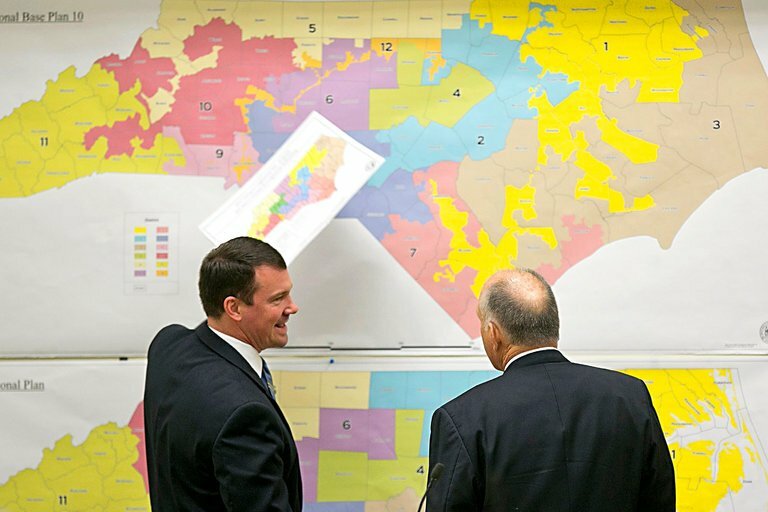“Redistricting is a lot like completing a homework assignment, turning it in, and only then being told what the assignment was.”
Brent Woodcox, special counsel at the General Assembly, drew that comparison during a panel discussion on gerrymandering at Campbell Law Review’s annual symposium last week. And there’s a lot of truth in it. Each decade, new legislative maps are drawn using census data to apportion voters into districts with roughly equal populations. These new maps are invariably challenged with a surge of litigation in state and federal courts, with challengers typically claiming that the map-drawers have improperly considered race or partisan advantage.
And with each round of litigation, courts craft new (and often opaque) standards. Or they attempt to make sense of previously crafted (and often opaque) standards. Or they punt on the issue altogether. Rarely do courts resolve even the most basic legal issues in a lasting way. After decades of litigation, the redistricting waters are muddier than ever and getting worse. So the symposium panelists, and many others, have reasonably concluded that we need clearer rules.
But that conclusion has a fundamental flaw: crystal-clear rules mean nothing when they are read inconsistently. The rules themselves aren’t the problem. The courts are.
The recent litigation over “extreme” partisan gerrymandering illustrates this issue well. For the better part of two decades, Stephenson v. Bartlett, 355 N.C. 354 (2002), was the cornerstone of redistricting jurisprudence in North Carolina. In that case, the Supreme Court of North Carolina took a deep dive into our state constitution and federal law to harmonize state and federal redistricting rules. In doing so, the Court set the ground rules for redistricting.
Most importantly, for this discussion, the Court concluded that it was, in fact, legal to draw the maps to favor one party or another. “The General Assembly may consider partisan advantage . . . in the application of its discretionary redistricting decisions” as long as it complied with the nine-part test set out by the opinion. If a supermajority of Democrats or Republicans arose from the new maps, so be it.
The Supreme Court of North Carolina echoed that conclusion twelve years later in Dickson v. Rucho, 367 N.C. 542, (2014). “The Supreme Court of the United States has recognized that compliance with federal law, incumbency protection, and partisan advantage are all legitimate governmental interests.” And when the case came back before the Supreme Court of North Carolina a year later, the Court said exactly the same thing.
In sum, the plainly settled law was that the legislature could maximize partisan advantage so long as the maps complied with the Stephenson test. On this point, Stephenson was unambiguous.
But in 2019, the three-judge panel in Common Cause v. Lewis threw that settled rule out the window.
The Common Cause panel found, for the first time in history, that “extreme” partisan gerrymandering violated the state constitution. The key provision in that case, according to the panel, was the “Free Elections clause” in Article I, Section 10, which reads, “All elections shall be free.”
That provision has been in our constitution, in some form, since 1776. The first iteration declared, “That elections of members, to serve as Representatives in General Assembly, ought to be free.” The practice of drawing maps to achieve partisan advantage was well-known then—though it would be decades before it was labeled “gerrymandering.”
The Free Elections clause was still part of our state constitution in 2002 when the Stephenson Court handed down its opinion affirming the legality (if not the wisdom) of drawing maps for partisan advantage. And yet, in 2019, the 243-year old Free Elections clause became exactly the white knight the courts needed to declare “extreme” partisan gerrymandering an illegal practice.
This is a truly remarkable reversal. In 2015, partisan advantage was a “legitimate governmental interest” in drawing maps. In 2019, without any changes to the underlying law, the practice became illegal.
And that brings us back to the flaw in concluding that “clear rules” will fix our redistricting issues. What good are clear rules when the courts are wildly inconsistent? How can we rely on a new constitutional provision to fix the problem when existing provisions are read in diametrically opposite ways from case to case?
An astute reader might point out that Common Cause didn’t reject all partisan gerrymandering, just “extreme” partisan gerrymandering. But this argument ignores the state and federal precedent identifying partisan advantage as a “legitimate governmental interest.” As such, the degree to which the General Assembly prioritizes partisan advantage is irrelevant so long as the Stephenson test is satisfied. Whether the partisan gerrymandering is extreme or slight, severe or modest, acute or infinitesimal matters not to the Constitution of North Carolina
The courts’ willingness to completely reverse course on this issue is troubling. With all due respect to proponents of redistricting reform, new rules will not rein in a judiciary that frequently moves the target and occasionally reverses course. New rules will only provide new battlegrounds for endless litigation.
And more litigation is the absolute last thing we need.


